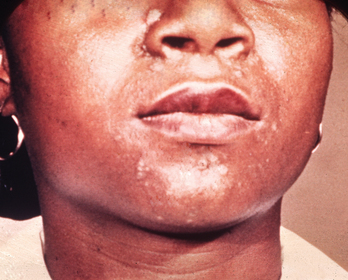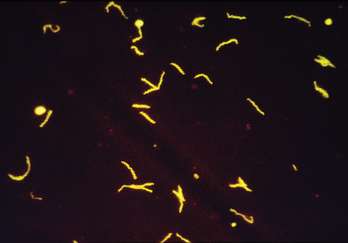CASE 26
PHYSICAL EXAMINATION
LABORATORY STUDIES
Diagnostic Work-Up
Table 26-1 lists the likely causes of the woman’s illness. Herpes can be ruled out by Tzanck smear (a cytologic examination to detect HSV-infected cells). Additional tests for confirmation of the clinical diagnosis may include
TABLE 26-1 Differential Diagnosis and Rationale for Inclusion (consideration)
Rationale: A clinical diagnosis of sexually transmitted disease (STD) should be considered based on the patient’s medical and social history. Inguinal lymphadenopathy can be seen with any of the pathogens listed. Primary ulcers are seen with all of the organisms, with some being associated with painful ulcers (H. ducreyi and HSV) and others with painless ulcers (T. pallidum). A febrile episode with generalized rash postprimary genital lesion is a distinctive feature associated with one of the listed pathogens. LGV and donovanosis are extremely rare in the United States (exposure history in the endemic areas is required for consideration).
MICROBIOLOGIC PROPERTIES
Treponemes are spirochetes, which are thin-walled, flexible, spiral rods and are invisible by light microscopy. Treponemes have a dual membrane system akin to, but dramatically different from, Gram-negative bacteria. They exhibit characteristic corkscrew motility due to axial filaments (endoflagella), which can be seen by darkfield microscopy (Fig. 26-2), used in clinical practice for visualization. Treponemes do not grow in bacteriologic media or in cell culture. Treponemal membrane lipids, particularly cardiolipin, induce nonspecific antibodies that cross-react with beef heart cardiolipin. This reactivity with lipoidal antigens is the basis of nontreponemal screening (rapid plasma regain [RPR] and Venereal Disease Research Laboratory [VDRL]) tests. These tests convert to reactivity early in disease, and titers wane with successful treatment. Patients with autoimmune diseases, such as SLE, may demonstrate false-positive reactions to nontreponemal tests. Fluorescence treponemal antibody-absorption (FTA-Abs) or microhemagglutinin-T. pallidum (MHA-TP), which detects T. pallidum-specific antibodies, is specific and confirmatory. These tests become positive later in disease and remain elevated, often for life.
Stay updated, free articles. Join our Telegram channel

Full access? Get Clinical Tree




